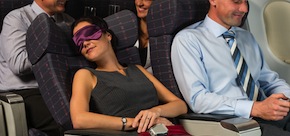For many people, flying can be daunting. Whether or not you have a fear of flying, the prospect of being cooped up on a plane for hours on end isn’t exactly exciting.
So how can you make long haul flights as hassle free as possible? Here are five tips to ensure you arrive at the other end feeling rejuvenated and ready to go.
1. Seat location is everything
This goes for all flights but especially international ones. Your seat can make a massive difference. Most airlines will allow you to manage your booking online and choose your seat as far as a week before your departure.
Think about whether you would prefer an aisle seat or a window – we’d avoid a middle seat at all costs. If you like to sleep for most of the flight, a window seat will keep you from being disturbed. However, if you like to move around or have easy access to the toilet, an aisle seat will be better with the added bonus of some extra space.
In addition, look at the seat map and think about where you want to sit in relation to the toilets, exit row seats and baby basinets. Remember, turbulence is also often more noticeable at the back of the plane.
2. Plan your attack
Before you fly think carefully about how you want to approach the flight. Do you want to sleep most of the way? Do you prefer to watch movies? Do you get very hungry if you miss the meals?
Clearly, the more sleep you have the more, the more rested you’ll feel when you arrive. However, it’s worth taking into consideration the time zone of where you are going – you don’t want to be wide awake when it’s everyone else’s bed time.
Make sure you have everything you need to enjoy your flight as much as possible. If you want to sleep, think about sleeping tablets, a neck pillow, eye mask and ear plugs. If you want to make the most of the entertainment system, take a good pair of headphones or a great book to keep you occupied.
3. Avoid C.R.A.P
Please note the full stops in the above – we promise we’re not swearing. C.R.A.P stands for caffeine, refined sugar, alcohol and processed foods. Obviously you are at the mercy of what the airline offers foodwise, however, there are still some steps you can take to feel as fresh as possible upon arrival.
Flying is very dehydrating and caffeine and alcohol only exacerbate this. If you want to enjoy a drink, make it earlier in the flight (it will help take the edge off), as downing cups of coffee or alcoholic drinks will leave you feeling tired and wired when you land.
Similar advice applies to consuming sugar and processed foods. Take a look at the meal options well in advance and select what you think will best suit your body. When in doubt, stick with some version of protein and vegetables to fuel your body for the flight.
4. Stay hydrated
One of the best things you can do for your body on inflight is to keep up your fluids. Forget all the various options, water is your savior for remaining hydrated. Studies show that a high level of water consumption may even combat jetlag. Force yourself to drink water every hour or two.
Don’t forget about the rest of your body either. Make sure you pack a good moituriser, hand cream and lip balm in your carry-on bag and use them regularly. Your skin and lips will thank you for it.
5. Move it or lose it
While it’s tempting – particularly if you like to curl up and just sleep – to stay in your seat, this won’t benefit your body. Wear flight socks to reduce the risk of swelling and deep vein thrombosis (DVT) and get up every hour or so to walk around the cabin.
Finding some space near the toilets to swing your legs, do some ankle circles and neck stretches will keep your blood flowing and limit the likelihood of you landing with pain from being crammed in a confined seat for hours on end.
What’s your tried and tested tip for making the most of a long haul flight?

